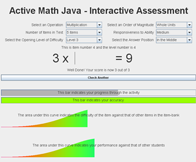Active Math Java
Item formats and screenshots
Screenshots
Click on a thumbnail in the table below to view full sized screenshots.
 |
 |
 |
 |
 |
 |
 |
 |
 |
 |
 |
 |
Active Math Java
Item formats
Active Math Java offers three item layouts:
- Right hand side: This is the conventional layout with the answer on the right hand side.
- Middle: This is the first algebraic format in the form a + x = b, where a and b are given and the student has to solve for x. Some people call this a number puzzle.
- Left hand side: This is the second algebraic format in the form x + a = b, where a and b are given and the student has to solve for x. Some people call this a number puzzle.
Active Math Java offers four numeric operations:
- Addition
- Subtraction
- Multiplication
- Division
Active Math Java offers seven orders of magnitude:
- Whole integers: These are traditional primary school sums, differences, products and quotients of whole numbers.
- Whole tens: For items in the conventional form a + b = x, where a and b are given and the student has to solve for x, both a and b are raised by a single power of 10 for addition and subtraction, but only a is raised by a single power of 10 for multiplication and division.
- Whole hundreds: For items in the conventional form a + b = x, where a and b are given and the student has to solve for x, both a and b are raised by the second power of 10 for addition and subtraction, while for multiplication and division both a and b are raised by a single power of 10.
- Whole thousands: For items in the conventional form a + b = x, where a and b are given and the student has to solve for x, both a and b are raised by the third power of 10 for addition and subtraction, while for multiplication and division a is raised by the second power of 10 and b is raised by a single power of 10.
- One Decimal Place: For items in the conventional form a + b = x, where a and b are given and the student has to solve for x, both a and b are reduced by a single power of 10 for addition and subtraction, but only a is reduced by a single power of 10 for multiplication and division.
- Two Decimal Places: For items in the conventional form a + b = x, where a and b are given and the student has to solve for x, both a and b are reduced by the second power of 10 for addition and subtraction, while for multiplication and division both a and b are reduced by a single power of 10.
- Three Decimal Places: For items in the conventional form a + b = x, where a and b are given and the student has to solve for x, both a and b are reduced by the third power of 10 for addition and subtraction, while for multiplication and division a is reduced by the second power of 10 and b is reduced by a single power of 10.